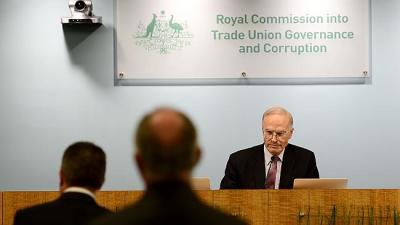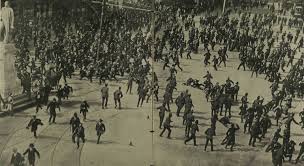The timing of the release of the interim findings of the Abbott Government’s Royal Commission into Trade Union Governance and Corruption demonstrated that even the Government now realises the Commission has failed to land a significant blow against the Australian trade union movement. Commissioner John Dyson Heydon’s interim report was released to little media fanfare on December 19, the Friday before Christmas.
The Commission’s interim report is a product of the highly political terms of reference written by the Abbott government, and of the biased approach of Commissioner Heydon and Counsel Assisting Jeremy Stoljar. Yet it still fails to paint a picture of anything nearing widespread corruption in the trade union movement.
The two relevant stories dominating the media prior to the announcement of the Royal Commission were allegations about former prime minister Julia Gillard’s role in the establishment of an Australian Workers Union slush fund more than two decades ago, and the corruption in the Health Services Union East Branch revealed by “whistleblower” Kathy Jackson, national secretary.
The sustained campaign led by Liberal politicians and the Murdoch press to implicate Gillard in wrongdoing as a solicitor in 1992 fizzled out and Counsel Assisting’s final submissions to the Commission published on October 31 stated that she “did not commit any crime and was not aware of any criminality” on the part of her former boyfriend, Bruce Wilson, and his then AWU colleague Ralph Blewitt.
In contrast, court actions during 2014 have revealed that Jackson – described as a “hero” by Abbott in 2012 and initially viewed by the Commission as its star witness – is the subject of litigation brought by the HSU, which is seeking to recover $1.4 million she allegedly stole from the union between 2004 and 2010. The Commissioner quietly averted his gaze in his interim report, and Jackson is mentioned on just six of its more than 1,800 pages.
Body count unimpressive
This approach of a Royal Commission avoiding making findings on issues that are the subject of ongoing court action is sound, and is supported by both the Commission’s terms of reference and High Court precedent, but it has not been used consistently. Heydon has produced detailed findings, including recommendations that prosecuting authorities “consider” criminal charges, in several cases involving officials from the Construction, Forestry, Mining and Energy Union that are before the courts.
The Commissioner in his interim report retreated somewhat from Stoljar’s bald statements in his final submissions that officials had “committed criminal offences” after receiving spirited responses from the CFMEU and other unions which pointed out that the Commission did not have the power to make findings of guilt.
The Commission was constituted 13 March 2014. After 76 days of hearings, 687 notices to produce, 239 witness appearances and $53 million of public money, the results must be disheartening, to say the least, to the Abbott government.
Aside from the already known existence of corruption among a number of officials in the HSU East Branch, and the Wilson-Blewitt AWU slush fund affair, it has failed to uncover systemic – or even any other significant cases of – corrupt self-enrichment by union officials at the expense of union members. Stoljar conceded in his final submissions that allegations of CFMEU officials in New South Wales and Queensland receiving or seeking bribes were “unsubstantiated”.
“The body count has been so low some in the media room took to joking about being assigned to cover [the New South Wales Independent Commission Against Corruption], where it reached double digits with 12 state or federal Liberal MPs who have resigned or stood aside,” journalist for Thomson Reuters’ industrial relations news service Paul Karp wrote on November 11.
Karp also commented on the failure to land any blows against Transport Workers Union national secretary Tony Sheldon over a union fund used in political and union campaigns. Unable to recommend that any charges should be laid, Stoljar “was reduced to observing that his conduct evinces a ‘culture of entitlement’ among the fund directors. If it was their money in their fund, perhaps they were entitled to think it could be used by them for their benefit.”
There are several cases where Heydon recommends prosecuting authorities consider charging individuals, but in almost all instances, these cases relate to industrial action.
The interim report does not make recommendations for policy reform; however, Stoljar’s submissions indicate the Commission will recommend attacks on industry superannuation funds and attempts to further regulate industrial relations by corporations law and criminal law. [These anticipated policy recommendations will be the subject of a future article in this series.]
Stage managing
Leaving aside for the moment the approach of the Commission and the content of its case studies, it’s worth taking a look back at the highlights of the political theatre of the past year that has been orchestrated by the Abbott government and the officers of the Commission itself.
From the start, Murdoch’s Herald-Sun newspaper appears to have been granted special access to the office of the Commission. A major leak in relation to the subject and content of private hearings and future public hearings in July went to several outlets, including the Herald-Sun and the Age.
On 3 July 2014, the day the CFMEU’s counsel was informed that hearings the following week would include a case study in Melbourne being the Pentridge Prison site”, the Herald-Sun said there would be “an explosive video and claims of corruption, death threats and intimidation” aired in the Commission the following week.
The following day, the Age uploaded video and audio recordings as part of its allegations around the Pentridge site. The same day, 4 July 2014, the Age also ran allegations it said were from private hearings.
The CFMEU wrote to the chief executive officer of the Commission, Jane Fitzgerald, saying: “These events suggest that not only the subject of next week’s Commission hearings but the evidence itself has been leaked to the media.” The union called on the office of the Commission to ask the Australian Federal Police to “investigate whether anyone from the Commission has been involved in the leaking of material to the media”.
Fitzgerald, and then Heydon, simply dismissed out of hand the allegation that officers of the Commission had been involved in a leak and refused to have the matter investigated internally or independently.
When a female lawyer working for the Commission was physically assaulted and injured in a car park on 18 September 2014, the Herald-Sun ran the story the following morning including the line: “The commission released a statement last night exclusively to the Herald-Sun”. The attack was random and unrelated to any aspect of the Commission, and the Herald-Sun did not explicitly claim there was a connection, though it mentioned the CFMEU and “bikies” in the article. But why is a royal commission providing selective briefings and “exclusive statements” to a favoured media outlet instead of issuing a general press release?
In July 2014, the ACTU was leaked a copy of a ‘scoping questionnaire’ that had been sent to all federal government departments and agencies by the Attorney General’s department asking them to disclose all contact with any union over the previous 10 years. ACTU Assistant Secretary Tim Lyons wrote in Working Life on 29 July 2014, “Although it’s notionally about the royal commission into unions, it goes well beyond the Commission’s terms of reference and seems to imply that any consultation with unions on public policy matters, and even negotiating a workplace agreement with unions representing public servants is somehow illegitimate”.
Those who said the union movement’s claim that the royal commission was a politically motivated witch-hunt was exaggerated should have been forced to think twice after the Attorney General department’s demand.
Then on 8 October 2014, Attorney General George Brandis announced that the Heydon royal commission would be extended by a year, and its terms of reference widened. Brandis said this was in response to the letter he received from Heydon reporting on his progress the previous week. But Heydon had clearly stated: “This letter is neither an application to widen the terms of reference nor an application to extend the reporting date.”
Brandis pushed out the reporting date by a year from December 2014 to December 2015. He boosted the Commission’s budget from $53 million to $61 million.
Clearly another year of mud-slinging against the union movement will give the deeply unpopular Abbott government a better chance of winning public support for its plan to make major reforms to the workplace relations system following the Productivity Commission’s review of the Fair Work Act which began in December. It means the Commissioner’s final report will be released in the lead-up to the 2016 federal elections.
The federal opposition pointed out that Brandis had taken just five days to respond to Heydon’s letter, but more than two months to respond to Justice Peter McLellan’s July actual request for an extension in the Royal Commission into Institutional Responses to Child Sexual Abuse.
Brandis confirmed during Senate Estimates that “the government made the decision to extend the Royal Commission”.
Election stunts
Then there was joint police task force into union-related crime that got announced twice – once by the Attorney General’s department in February 2014, and once more for luck on 31 October 2014, shortly before the Victorian state election.
Opposition leader Bill Shorten had proposed creating a “multi-jurisdictional taskforce” in February 2014. The CFMEU has written to the police commissioners of Victoria and NSW several times since January 2014 pledging the union’s full cooperation with the police in any investigation into criminal activity in the building industry.
But the theme of the Victorian state election, a contest in which the first-term Napthine government was struggling, was set.
The Victorian Police Commissioner Ken Lay was informed the night before the 31 October announcement, by email, that then Victorian Premier Denis Napthine and Abbott would be holding a press conference in the morning about the joint police task force.
That evening Tom Iggulden reported on the ABC News: “The Herald-Sun was, however, kept in the loop. Details of the taskforce unknown to the [police] commissioner were splashed across the News Limited outlet this morning.” The front page headline read, “Cops hunt union rats”.
The task force would include up to 30 Victorian and federal police officers who would investigate allegations aired by the Heydon Commission, and report back to the Commission.
Question Time in the federal parliament was dominated by feverish claims in the weeks leading up to the Victorian vote, with federal justice minister Michael Keenan saying on 26 November that “Voters in Victoria need to be aware that a vote for Labor on Saturday is literally a vote for the CFMEU to have a seat at the cabinet table.” Education minister Christopher Pyne claimed the day before that “[Victorians] do not want the bikies back running Victoria. A vote for Labor on Saturday is a vote for the CFMEU and John Setka.”
All of which of course made the Liberal loss of government, ensured by a grass-roots campaign by trade union activists led by Victorian Trades Hall Council, all the sweeter.
And lastly, the timing of the release of the terms of reference for the Productivity Commission’s review of the Fair Work Act – delayed since March 2014 and announced on the Friday before Christmas, minus Abbott, and just a few hours after Heydon’s interim report was released – was the final act in a year of politically motivated and orchestrated stunts relating to this royal commission.
Despite the combined efforts of the government and the Commission itself, it’s fallen flat. But then, the Abbott government has given it another year to do better.










